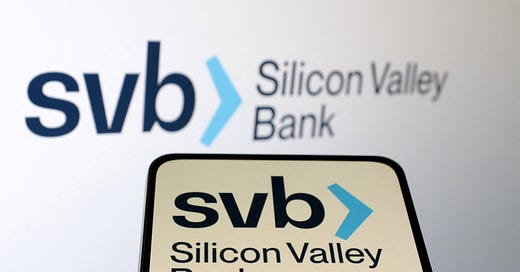The collapse of Silicon Valley Bank - here is what happened | #28
Inside the 4 days that shook the startup ecosystem
Imagine you are a startup founder. You worked hard for many years to build up your business, hired hundreds of employees, and raised millions of dollars from investors. One morning you wake up and everything is... gone. Poof. Just like that.
That's the situation thousands of startup founders found themselves amidst the collapse of Silicon Valley Bank (SVB) on Friday. SVB was the 16th largest bank in the United States and more than 37,000 startups banked with them. Here is a story of the wild 4 days that shook Silicon Valley, but ultimately ended with good news.
Why companies chose SVB
Before we dive into what happened, let’s set the stage for why over 50% of tech startups chose to bank with SVB. The Silicon Valley Bank might not be well-known internationally, but they were the most startup friendly bank, even before startups were cool.
One of SVB’s main business lines was providing venture debt to tech startups who recently raised a round of financing. If a startup raised a $5M round, SVB would come in and offer additional 20-30% (in this case $1M) at really favorable rates. It was one of those deals that startups just couldn’t refuse. And there wasn’t a big catch with the venture debt, except that you had to “bank with SVB”. For startup founders, it wasn’t an issue - the bank had a really strong reputation for decades and was well known in the startup ecosystem.
The bank was really involved in the tech ecosystem as well. When I worked for a VC firm in San Francisco, SVB sponsored our events, helped our startups, and was the main banking partner for our funds. Through their involvement and partnerships with VC firms, they were able to land most prominent startups as their clients. That’s how the bank ended up being the main banking partner for over 37,000 startups and 2,500 venture capital firms.
What happened
It all started with the shut down of a crypto bank Silvergate on Wednesday. The bank had lost more than $1 billion in Q4 2022 and was not well-capitalized to continue its operations. The shutdown sent shockwaves across the crypto and startup ecosystems. Then, to add fuel to the fire, the Silicon Valley Bank announced its plan to sell $2.25 billion worth of its shares to pop up its balance sheet. The bank wanted to add cushion amidst millions of dollars in unrealized losses because of their investments in long-term treasuries.
The timing of the announcement couldn’t be worse. The news raised alarms among the investor and startup community who started speculating that the bank might be in trouble. VCs started recommending their portfolio companies to transfer their capital out of SVB and the hysteria spread all over Twitter.
What followed was a bank run. But unlike in the old times where people had to physically go to banks to withdraw money, everything was done digitally at a much faster pace. In a matter of a day, the bank started running out of money and the government agency FDIC had to step in and take over the funds.
But doesn't the government insure the funds?
Yes, it does. But only up to $250,000 per account. An average bank has 50% of money insured because customers are individuals. But we are dealing with startups here who held millions of dollars in the bank. Only 7% of the total deposits were insured by the government and were guaranteed to clients. And the bank had $180 Billion in deposits. So $167 billion out of 180 was NOT insured. Now, it didn’t mean that clients wouldn’t get their money. The rest of the funds could also be returned but only AFTER the sale of SVB’s assets, which could take YEARS.
Startups were scrambling to run payroll on Friday, let alone wait for years to get their money back. By that time, most of the impacted startups wouldn’t exist.
The event was so severe that it risked thousands of startups to do mass layoffs or shut down completely in a matter of weeks. Garry Tan, the CEO of Y Combinator, called it an “extinction level event for startups”.
Collective effort and a relief
The startup community rallied together to come up with solutions. Y Combinator along with 2,800 startup founders filed a petition to the regulators to make all depositors whole. Fintech startup Brex started a $1 billion raise to help provide loans to startups who were impacted. Payroll provider Deel made $120 million of its own cash available to impacted startups to run payroll in the upcoming month. Investors like Vinod Khosla and OpenAI CEO Sam Altman offered their own capital as loans to startups.
But on Sunday morning, everybody finally exhaled and a collective relief was felt across Silicon Valley. The US Fed announced that everybody who banked with SVB will be made whole. All funds, both insured and uninsured, will be available to SVB clients on March 13th (today!)
But more importantly, the government passed a new policy that provides liquidity for other banks that are under stress. This potentially stops a huge ripple effect that would’ve affected other regional banks.
For now, it feels like a huge crisis is averted. But the effects of collapse will linger in the tech community for decades to come.
If you found this essay helpful, please share it with friends and colleagues





